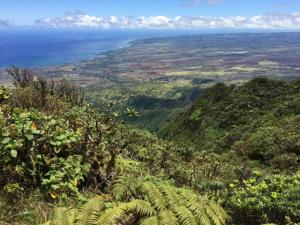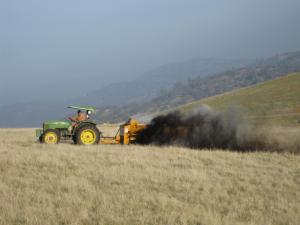Soil holds potential to slow global warming
Appropriate management of soil and its organic matter can significantly offset carbon emissions
University of Hawaiʻi at MānoaAssistant Professor, Natural Resources and Environmental Management
Rebecca Ryals, (808) 956-8723
Assistant Professor, Natural Resources and Environmental Management
Want to do something about global warming? Start by looking at the ground. Managed well, soil has an ability to trap carbon dioxide that is potentially much greater than previously estimated, according to a recent University of Hawaiʻi at Mānoa study that claims the resource could “significantly” offset increasing global emissions. The authors call for a reversal of federal cutbacks to related research programs so that scientists can learn more about this valuable resource.
The work, published in two overlapping papers in Annual Review of Ecology, Evolution and Systematics and Global Change Biology co-authored by two researchers in UH Mānoa's College of Tropical Agriculture and Human Resources (CTAHR), emphasizes the need for more research into how soil, if managed appropriately, could mitigate some of the effects of a rapidly changing climate.
“Many people think of the soil as just dirt,” said Susan Crow, a soil ecology professor in the Department of Natural Resources and Environmental Management (NREM) in CTAHR and a coauthor of both papers. “But caring for the land by maintaining or rebuilding organic matter, rich in carbon and essential for the life of soil, is a win-win for building resilience in our landscapes and communities through protection of food security, reduced erosion and water pollution, and improved drought tolerance.”
Humble yet mighty
Organic matter in soil, such as decomposing plant and animal residues, stores more carbon than do plants and the atmosphere combined. Unfortunately, the carbon in soil has been widely lost or degraded through land-use changes such as unsustainable forest and agricultural practices, fires, nitrogen deposition, and other human activities. The greatest near-term threat comes from thawing permafrost in Earth’s northern reaches, which could release massive amounts of carbon into the atmosphere.
Despite these concerns, there is still great promise, according to the study’s lead authors. Improving how the land is managed could increase soil’s carbon storage enough to offset future carbon emissions from thawing permafrost, the researchers find. Among the possible approaches: reduced tillage, year-round livestock forage, and compost application. Planting more perennial crops, instead of annuals, could store more carbon and also reduce erosion by allowing roots to reach deeper into the ground.
Crow, along with co-author Rebecca Ryals, an agricultural ecologist also in NREM, and their colleagues found that about 70 percent of all sequestered carbon in the top meter of soil is in lands directly affected by agriculture, grazing, or forest management – an amount that surprised the authors. They were also surprised to find that plant roots are five times more likely to turn into soil organic matter than the same mass of leaves. “Retaining and restoring soil organic matter helps farmers grow better crops, purifies our water and keeps the atmosphere cleaner,” said lead-author of the AREES paper Rob Jackson of Stanford University.
Overcoming obstacles
The study provides the most complete estimate yet of carbon in peatland and permafrost – almost half of the world's estimated soil carbon. It describes an unexpectedly large stock of potentially vulnerable carbon in the northern taiga, an ecosystem that is warming more rapidly than any other. These carbon stocks are comparatively poorly mapped and understood.
The paper warns of a possible danger: overestimating how the organic matter in soil is distributed. The co-authors calculate there may be 25-30 percent less than currently estimated due to constraints from bedrock, a factor previously not analyzed in published scientific research.
While scientists are now able to remotely map and monitor environmental changes on Earth’s surface, they still don’t have a strong understanding of the interactions among biological, chemical and physical processes regulating carbon in soils. This knowledge is critical to understanding and predicting how the carbon cycle will respond to changes in the ecosystem, increasing food production, and safeguarding natural services we depend on, such as crop pollination and underground water storage.
A rapidly changing climate – and its effects on soil – make these scientific advances all the more urgent. “Soil has changed,” said Jennifer Harden, lead author of the Global Change Biology paper. “We can’t use the soil maps made 80 years ago and expect to find the same answers.”
However, funding pressures such as federal cuts to climate science, combined with turnover in science staff and a lack of systematic data, threaten progress on soil carbon research. The authors call for a renewed push to gather significantly more data on carbon in the soil and learn more about the role it plays in addressing climate change and food security. They envision an open, shared network for use by farmers, ranchers, and other land managers as well as policymakers and organizations that need good data to inform land investments and conservation.
“As we learn more about the soil under our feet, we can be better equipped to make decisions that will help us grow food, protect natural ecosystems, and combat climate change,” said Ryals. State-level soil health actions, including Hawai‘i’s recent Carbon Farming Task Force (Act 33, SLH 2017), can benefit greatly from soil carbon data networks and further solutions-based research.
Funding for the papers came from the U.S. Department of Agriculture, the Gordon and Betty Moore Foundation, the National Science Foundation, the Swedish Research Council, the Inter-American Institute Collaborative Research Network, the Comision Sectorial de Investigacion Cientıfica and the Proyecto Plurianuales de Investigacion, the U.S. Geological Survey, the Bolin Climate Research Center at Stockholm University, the EU JPI Climate consortium, the U.S. Department of Energy and the Pacific Northwest National Laboratory. The paper resulted from a 2017 an International Soil Carbon Network workshop funded by Stanford’s School of Earth, Energy & Environmental Sciences.


